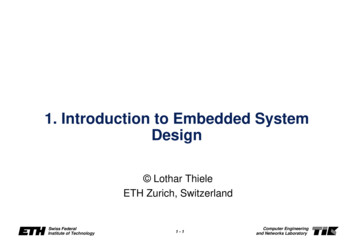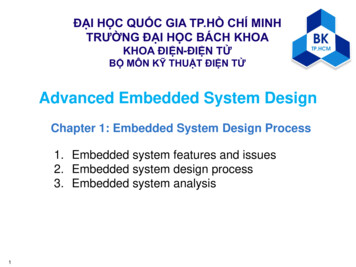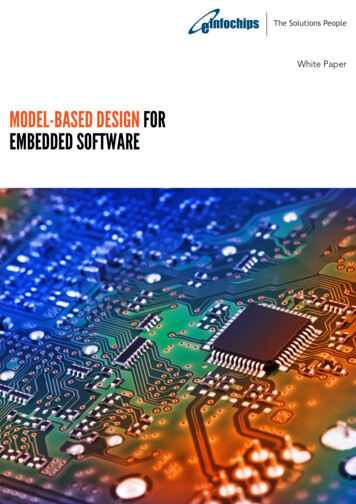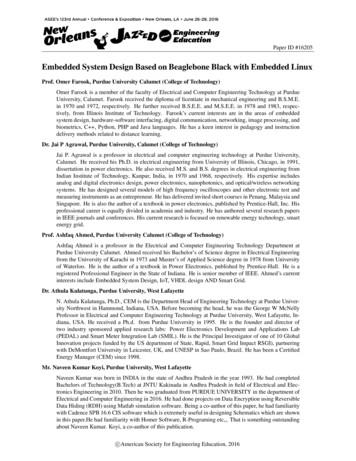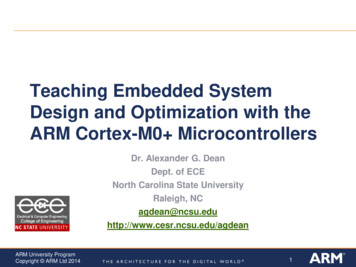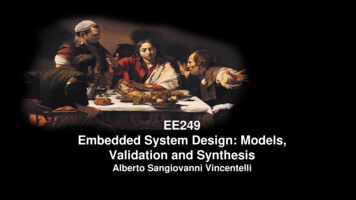
Transcription
EE249Embedded System Design: Models,Validation and SynthesisAlberto Sangiovanni Vincentelli1
eMerging Societal-Scale SystemsNew System ArchitecturesNew Enabled ApplicationsMassive ClusterGigabit Ethernet ClustersDiverse, Connected, Physical,Virtual, EmbeddedSystemsMEMSBioMonitoring2Scalable, Reliable,Secure Services
Embedded Systems Computational– but not first-and-foremost a computer Integral with physical processes– sensors, actuators Reactive– at the speed of the environment Heterogeneous– hardware/software, mixed architectures Networked– shared, adaptiveSource: Edward A. Lee3
Observations We are on the middle of a revolution in the way electronics products aredesigned System design is the key (also for IC design!)– Start with the highest possible level of abstraction (e.g. controlalgorithms)– Establish properties at the right level– Use formal models– Leverage multiple “scientific” disciplines4
Course ehaviorvs. ArchitectureComputationvs. Communication5
Behavior Vs. ArchitectureModels ofComputation1QuantityestimationComm. and ping3RefinementSynthesis: HWand SWAssign functionality toarch elementsHW/SW partitioning,SchedulingFlow To Implementation 4 Polis (1990-1996) VCC (1996-2003)6 Metropolis (2003-present)
Behavior Vs. Communication Clear separation between functionality and interaction model Maximize reuse in different environments, change only interaction modelETROPOLIS7
EE 249Embedded System Design: Models, Validation, and SynthesisLectures: TuTh 11-12:30PM, 521 CoryDiscussion and Lab: Tu 5-6PM, Th 4-6PM, 540A/B CoryInstructor:Alberto Sangiovanni-Vincentelli (alberto@eecs.berkeley.edu)GSI:Pierluigi Nuzzo (nuzzo@eecs.berkeley.edu)CCN: 25709, 26035Units: 4Course Topics1. IntroductionDesign complexity, examples of embedded and cyber-physical systems,traditional design flows, Platform-Based Design, design capture andentry2. Functional modeling, analysisand simulationOverview of models of computation. Finite State Machines, ProcessNetworks, Data Flow, Petri Nets, Synchronous Reactive, Hybrid Systems.Unified frameworks: Tagged Signal Model, Agent Algebra. Compositionalmethods and Contract-based Design.3. Architecture and performanceabstractionDefinition of architecture, examples. Distributed architecture,coordination, communication. Real time operating systems, scheduling ofcomputation and communication.4. MappingDefinition of mapping and synthesis. Software synthesis, quasi staticscheduling. Communication Synthesis and Communication-Based Design.Design Space Exploration.5. VerificationValidation vs. Simulation. Simulation of heterogeneous systems. Formalmethods. Verification of hybrid system. Horizontal and Vertical Contracts.Interface automata and assume-guarantee reasoning.6. ApplicationsAutomotive: car architecture, communication standards (CAN, FlexRay,AUTOSAR), scheduling and timing analysis. Building automation:Communication (BanNet, LonWorks, ZigBee). Aircraft vehiclemanagement system. Electrical power system embedded control.Grading will be based on a final project, lab/HW assignments and literature discussions.
Administration Course web page:http://chess.eecs.berkeley.edu/design/ All announcements made through Piazza– Enroll athttps://piazza.com/berkeley/fall2012/ee249– Students can post questions on the class material, HW, Labs and tools (alsoanonymously)– Instructors or other students can answer questions9
Administration (cont.)Credit: EE 249 is a 4 unit course. Alberto L. Sangiovanni-Vincentelli - 515 Cory Hall - Email: alberto at eecs dot berkeley dotedu. Office hours: Tues/Thurs, 12:30-1:30 pm, 515 Cory, or by appointment. Pierluigi Nuzzo - GSI - 545H Cory Hall - Email: nuzzo at eecs dot berkeley dot edu. Officehours: Tues, 4-5 pm, 540A/B Cory, or by appointment. Lectures: Tuesday and Thursday, 11-12:30 pm, 521 Cory Hall.Discussion: Tuesday, 5-6 pm, 540A/B Cory Hall.Lab Sessions: Thursday, 4-6 pm, 540A/B or 204 Cory Hall. EE 249 Fall 2012 Piazza website: https://piazza.com/berkeley/fall2012/ee249 Grading Policy:––––10Course project: 50%Lab: 20%Homework: 20%Discussion: 10% Alberto Sangiovanni-Vincentelli. All rights reserved.
Schedule Labs (Th. 4-6):– Presentation of tools followed by hands-on tutorial and assignments Discussion Session (Tu. 5-6)– Each student (possibly in groups of 2 people) will have to make one or more oral presentationsduring the class Last week of class dedicated only to projects (usually due the last week of November or the1st week of Dec.) Auditors are OK but please register as P-NP (resources are assigned according tostudents )11
Introduction Outline Evolution of IT Systems Cyber-physical Systems– Societal Scale Systems– Automobile of the future– Smart grid and buildings The Far Future– Bio-Cyber Systems Design Challenges
The Emerging IT Scene!InfrastructuralcoreThe Cloud!SensoryswarmMobileaccessCourtesy: J. Rabaey13 Alberto Sangiovanni-Vincentelli. All rights reserved.
Computers and mobiles to disappear!Predictions: 7 trillions devices servicing 7 billion people!1,000 devices per person by 2025The Immersed HumanReal-life interaction between humans and cyberspace, enabled by enriched input and outputdevices on and in the body and in the surrounding environmentCourtesy: J. Rabaey
IBM Smarter Planet Initiative: Something profound ishappening CYBER PHYSICAL SYSTEMS!INSTRUMENTEDINTERCONNECTEDINTELLIGENTWe now have the ability tomeasure, sense and see theexact condition of practicallyeverything.People, systems and objects cancommunicate and interact witheach other in entirely new ways.We can respond to changes quicklyand accurately,and get better resultsby predicting and optimizingfor future events.15
Intelligent systems that gather, synthesize and applyinformation will change the way entire industries operate.Smart waterApply monitoring and managementtechnologies to help optimize theavailability, delivery, use, and quality ofwater as well as related systemsincluding energy and chemical treatment.Smart trafficSmart energyUse real-time traffic prediction anddynamic tolling to reduce congestion andits byproducts while positively influencingrelated systems.Analyze customer usage and providecustomized products and services that helpto boost efficiency from the source throughthe grid to the end user.CongestionWaterEnergy rcesSmart home
Vision 2025Integrated components will be approaching molecular limits and/ormay cover complete walls- Every object will be smart- The Ensemble is the Function!-- Function determined by availability of sensing, actuation, connectivity,computation, storage and energy-Collaborating to present unifying experiences or to fulfill commongoalsA humongous networked, distributed, adaptive, hierarchicalcontrol problem
Outline Evolution of IT Systems What is possible? Cyber-physical Systems– Societal Scale Systems– Automobile of the future– Smart grid and buildings The Far Future– Bio-Cyber Systems Design Challenges
The Birth of Cyber-Physical SystemsComplex collections of sensors,controllers, compute and storagenodes, and actuators that worktogether to improve our daily lives
An example of Cyber-Physical System (provided by UTC)
VMS Challenge Problem v1.0 (1Nov2010)VMS Functions (replace flight engineer)System Demonstrations Operate and monitor engine/aircraft systemscontrols and indicators; System startup: From a cold start, turn allsubsystems on and go into a normal operating mode Perform engine starts, monitor run-up, flightoperation and engine shutdown; Transport mission: pick up ground cargo usingwinch from hovering configuration, transport cargo asswung load to drop-off location, deposit on ground,and depart from area Operate engine controls to provide desiredefficiency and economy; Monitor engine instruments throughout period ofoperation; Control, monitor and regulate some or all aircraftsystems: hydraulic, pneumatic, fuel, electronic, airconditioning, pressurization; ventilation; lubricationcommunication, navigation, radar, etcVMS architecture (design exploration) Implement fully distributed system, with allsubsystems integrated across a networkedcommunications interface Landing operations: support aircraft landing ineasy (daylight, clear conditions), moderate (nighttimeand/or rainy conditions) and difficult (dusty with icyweather) conditions Safing mode: perform operations that put vehicle insafe operating mode, depending on condition ofvehicle System diagnostics: during normal operations, logdiagnostic data from all subsystems, w/ variableresolution
Where CPS Differs The traditional embedded systems problem– Embedded system is the union of computing hardware and software immersed in aphysical system it monitors and/or controls. The physical system is a given. Thedesign problem is about the embedded system only. Hybrid Systems– Mixed discrete and continuous time systems The CPS problem– Cyber-Physical Systems (CPS): Orchestrating networked computationalresources with physical systems– Co-design of physical system and controller– Computation and networking integrated with physical processes. The technicalproblem is managing dynamics, time, and concurrency in networked, distributedcomputational physical systems. Alberto Sangiovanni-Vincentelli. All rights reserved.
Modeling Cyber-Physical SystemsModelEquation-based modelAbstraction“physical l system (the plant)Courtesy: D. BromanEmbedded systems (computation)
Modeling Cyber-Physical Systems(Lee, ASV: A framework for comparing models of computation, IEEE Trans. CAD, 1998)Platform 1ActuatorPhysicalInterfacePhysical Plant 2NetworkPhysicalInterfacePlatform 2SensorComputation 1Delay 1Computation 4Computation 2SensorPlatform 3Delay 2PhysicalInterfaceComputation 3Physical PlantPlant 12PhysicalModelActuatorDifferent models of computationEquation-based modelAbstraction“physical modeling”Concept of ActuatorsPhysical system (the plant)Courtesy: D. BromanEmbedded systems (computation)
CS modeling challenges for CPSA richer, systems view of computer science is needed. Ingredients include:Enriching CS models with relevant physical/resource properties Physical, model-based computing Resource aware (time/energy) computingFormal composition of multiple physics, models of computation, languages Composition of heterogeneous componentsImpact of cyber components on physical components and vice versa Physically-aware computing
Automotive IndustryThree Levels of PlayersAutomakers 2005 Revenue: 1.1T CAGR 2.8% (2004-2010)Tier 1 Suppliers90% of revenue fromautomotive 2004 Revenue 200B CAGR 5.4% (2004-2010)IC Vendors 15% of revenue fromautomotiveSource: Public financials, Gartner 200526 2005 revenue 17.4B CAGR 10% (2004-2010)
The Evolution of the Automotive DNAEnergized byPetroleumEnergized byElectricity and HydrogenPowered Mechanically byInternal Combustion EnginePowered Electrically by tronicallyStand-alone“Connected”Totally Dependenceon the DriverSemi/Full Autonomous DrivingVehicle Sized for Maximum Use –People and CargoVehicle Tailored toSpecific Use
GM SAC Vehicular Electronics, Controls andSoftware StudySoftware content in automobiles could increase by 100 Xover the next 5-6 years. Challenges will include:– Software system architecture– Partitioning for modularity & system reliability– Reuse– Standardization of interfaces28
360 SENSING CAPABILITYTODAYFUTURE
V2V/V2X COMMUNICATIONS “Warning”“Warning”
CMOS mmWave Circuits and SoC: 60GHz Today Multiple 60GHz standards complete WirelessHD products available– SiBeam (BWRC startup)– Wall-powered– Dissipate 2W A 10 Radar is a possibility!31 Alberto Sangiovanni-Vincentelli. All rights reserved.
VEHICLE IS PART OF A “CONNECTED” ECO-SYSTEMInternetBack OfficeCall utoNet orVerizon MiFiCellularIn-CarAccess eddedLink“V2I”“V2V”VIIVSC-CAMPITS DemosCICAS
ELECTRIC, CONNECTED, AUTONOMOUS
The Tire of the FutureNew materials: enhanced performances, reduced rolling resistance,lower noise, reduced puncture risk, nanotechnologies, new compounds,new tread design, “self sealing” technologies.New design technologies: virtual engineering for reducing time to market& engineering costs.New electronics technologies inside the tire: pressure monitoring,friction, slip, tire consumption, contact force, “health” check-upinformation extraction & transmission.The Tire as an Intelligent Sensor!
Major broadcastchannel in ItalyCyber Tire SystemVehicle dynamicscontrol systemUserApplicationsMarco Tronchetti ProveraChairman of Pirelli & C. S.p.A.ProcessingunitReceiversCyber TireCyber Tire
Experimental TestsWide database Different tires Different sensorpositioning Different speeds Different tracksTyre insideAccelerometers–––––Steering padStraight lineBrakingAcceleration. Different conditions– Dry– Wet– Ice
Tread Length Estimation Minimum of the tangentialcomponent signal: tread area entry Maximum of the tangential componentsignal: tread area exitTread length60 6500 ap0 erp0 - Segnale filtrato -Tangenziale Centrale -Giro:1qcdPL Np / ƒc ω Rrot100[m/s 2 ]500PL : tread length-50Rrot : rolling radiusω : angular speedƒc : sampling 00 1100
Politecnico di TorinoCyber Tyre Development PartnersPrototype Vehicle Integration,Engineering SupportPolitecnico di MilanoFeature Extraction,Kinematics pre-conditionerPico-radio communication blockData processing and computingUniversity ofCalifornia, BerkeleyUltralow powerradioAdvanced newcommunicationprotocolsPhysical properties sensoring system (e.g.pressure, temperature, acceleration)Energy ScavengingIP and chipmanufacturingRX/TX antennaPower ManagementUMCValtronicTechnologies SAassembly andpackagingtechnologiesST Micro.MEMSAccelerometersAccent S.p.A.acquisition, processing andadvanced architecturaltechnologies
The Future Immersed Devices?Courtesy: Corning Glass“A World Made of Glass”(http://www.youtube.com/watch?v iY1Q0bNwXuI)
Building Energy Demand ChallengeBuildings consume 39% of total U.S. energy 71% of U.S. electricity 54% of U.S. natural gasBuilding produce 48% of U.S. Carbon emissionsCommercial building annual energy bill: 120 billionThe only energy end-use sector showing growth in energy intensity 17% growth 1985 - 2000 1.7% growth projected through 2025Energy Breakdown by SectorEnergy Intensity by Year Constructed40Sources: Ryan and Nicholls 2004, USGBC, USDOE 2004
Greenhouse Gas Emissions by Sector41The Problem
European Union thinking Buildings– From 2019 all new buildings produce as much energy as they consume– Member States set minimum targets for zero-energy buildings in 2020– Member States to set energy targets for existing buildings Residential– After 2018 must generate as much as consume via solar, heat pumps andconservation– Member States set energy targets for existing buildings by 2015
43Energy Efficient Buildings: Current State“One size fits all”Increasing integration of subsystems & controlDifferent types of equipmentMarket Penetration/Size and ReadinessDifferent skillsDifferent deliver“Climate Adaptive Design”Debitel Stuttgart, Germany120K ft2, 165kWhr/m2/yrKfW Frankfurt, Germany55K ft2, 100kWhr/m210-20%20-40%50% Energy Efficiency
Energy Efficient Buildings: RealityDesigns over-predict gains by 20-30%M. Frankel (ACEEE, 2008)Large Variability in Performance Predictions Performance simulations conducted (only) for peak conditions As-built specifications differ from design intent, resulting in compromise of energy performancedue to detrimental sub-system interactions Uncertainty in operating environment and loads
Energy Efficient Buildings: RealityActual energy performance substantially lower thandesign predictions due to detrimental sub-systeminteractions and control system issuesCambria Office BuildingDesign Intent: 66% (ASHRAE 90.1);44%KfW Building, Frankfurt, GERMANYDesign Intent: 100kWH/m2/yrMeasured“As designed” energy performance accomplished aftersubstantial system tuningSource: Lessons Learned from Case Studies of Six High-Performance Buildings, P. Torcellini, S. Pless,M. Deru, B. Griffith, N. Long, R. Judkoff, 2006, NREL Technical Report.
What is Hard (Missing): Products, Services and Delivery?Concept & DesignOperations & MaintenanceContractorsProperty Managers & OperationsStaffBarrier: ScalabilityClimate specific Multiple subsystems Dynamic energy flowsImplication on Cost Hardware/process for calibrationImplication on Risk No Design ProCert/quality processMissUnapproachableanalysis toolsAs-built variances from specLossCurrentStateUnawareLowEnergySavings PotentialA & E FirmsBuildPoor operationor maintenanceBarrier: RobustnessBarrier: Productivity Unknown sensitivities No supervisory controlImplication on Cost No ProCert process/quality process Commissioning costs/processImplication on Risk Control of design in handoffsNo diagnostics/guaranteed performance without consultingImplication on Cost Measurement costs Recommissioning costsImplication on Risk Facility operations skillsets Unbounded costs to ensure performance
They Don’t Even Create Comfortable EnvironmentsThe Problem
Really Not Just In DilbertUC Berkeley Center for the Built EnvironmentOccupant Satisfaction Survey Results, 35,000 responsesThe Problem
Molecular Foundry Performance Review, September 2010
Building Performance Problems Poor Controls Design No Modeling or Optimization Poor Controls Implementation Lack of Commissioning No Automated Fault Diagnostics Lack of information transfer from design to construction to operation
Building Information FlowBuilding Life-Cycle – 3 distinct phasesDesignConstructionOperationwith distinct playersEngineersConsultantsOwnersOperatorsFacility ManagersContractorsCommissioning Agentsroles / productsmonitoringbillingmaintenancerepairchanges / k flow & information flow is “manual”paper&PDFpaper&PDF
Complexity* in Building SystemsGoing from 30% efficiencyto 70-80% efficiency Components do not have mathematically similar structures and involvedifferent scales in time or space; The number of components are large/enormous Components are connected in several ways, most often nonlinearlyand/or via a network. Local and system wide phenomena depend oneach other in complicated ways Overall system behavior can be difficult to predict from behavior ofindividual components. Overall system behavior may evolvequalitatively differently, displaying great sensitivity to smallperturbations at any stage* APPLIED MATHEMATICS AT THE U.S. DEPARTMENT OF ENERGY: Past, Present and a View to the FutureDavid L. Brown, John Bell, Donald Estep, William Gropp, Bruce Hendrickson, Sallie Keller-McNulty, David Keyes, J. Tinsley Oden and LindaPetzold, DOE Report, LLNL-TR-401536, May 2008.52
Every Building is UniqueA380 10 billion to develop 300 million each to build Design 30 x constructionTypical Building Design 10% of construction cost53Building design about 1/300 of airplanedesign costs.
Outline Evolution of IT Systems Cyber-physical Systems– Societal Scale Systems– Automobile of the future– Smart grid and buildings The Far Future– Bio-Cyber Systems Design Challenges
The traditional embedded systems problem – Embedded system is the union of computing hardware and software immersed in a physical system it monitors and/or controls. The physical system is a given. The design problem is about the embedded system only. Hybrid Systems – Mix





